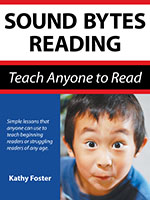Sound Bytes Reading is a relatively simple and inexpensive resource for teaching reading that is likely to be most effective for older students who struggle with reading and for ESL students. In the homeschool edition, the entire course is contained in a single 249-page book that is used by both parent and student.
The original, classroom-designed program has separate student and teacher books, but the combined and condensed homeschool edition should work fine for a parent working with just one child.
Sound Bytes uses an intensive phonics approach, and it stresses teaching handwriting (manuscript printing of lower-case letters) and spelling right along with reading as multi-sensory reinforcements.
The book is divided into three sections: a 19-page teacher’s guide, student materials (the bulk of the book), and an appendix.
Fewer than ten pages of the teacher’s guide actually explain how to use the program, so you can quickly figure out how to use it and begin. Lessons teach sounds of the individual letters—consonants and short vowels first. Blending is also taught in the first lesson. If you were beginning to teach young children at kindergarten level, you would not normally expect them to learn blending at the very beginning. However, with older students, they will probably already know some of the phonograms and will likely have at least some idea of how blending works. So they will probably have no trouble blending phonograms so quickly. The first lesson teaches five letters/phonograms (a, t, s, c, f), four words (at, cat, sat, fat), and the word a as a sight word. Then students immediately practice reading phrases such as “fat cat” then sentences such as “A fat cat sat.”
A set of movable letters can be created from the “Scramble-Spell” pages at the back of the book by photocopying them on to cardstock and cutting them out. These letters are used for reading and spelling activities throughout the lessons.
Students also should be learning handwriting (if they have not already done so) as they learn to read so that they practice writing words as they learn them. However, you will need to use another resource for instruction in forming the letters.
Students learn to spell as they learn to read, again for reinforcement. Spelling begins with the parent dictating sounds of each letter in a word rather than expecting students to already have mastered the complete spelling of new words.
The teacher guide information refers to diagnostic testing, but diagnostic tests are not included in the homeschool edition. However, working with one student, you should be able to fairly quickly have them read through key words of lessons from the beginning to identify a point at which they begin to exhibit problems. This is probably the most significant glitch that I found that resulted from the transition to this condensed version.
The student materials follow an orderly progression from short vowels to long vowels and from simple phonograms to more complex phonograms. The program even covers three of the sounds for “ough,” although there are a few more that are not taught—a list on p. 170 shows the phonograms and pronunciations that are not covered specifically in Sound Bytes, so you might teach these on your own.
Student materials are divided into four “chapters” each of which contains a number of complete lessons, each including practice reading material. The four sections are titles, Short Vowels, Long Vowels, The Advanced Code, and Challenge. Both of the first sections incorporate consonants. The Advanced Code adds more challenging phonograms such as “ch,” “tw,” “ow,” and “ou.” Students also learn compound words and suffixes such as “ed” and “ing.” Challenge lessons review much of what has already been learned but they put it together differently, teaching spelling patterns that make the same sounds. These lessons also teach the schwa sound. As students complete the last of the Challenge lessons, they are reading lengthy stories three to five pages in length that appear to be at about third or fourth grade level. Following the final lesson is a list of recommended books that students should be able to tackle after this.
The appendix has some charts and “posters,” but the most useful items are likely to be the instructions for teaching blends and the “Scramble-Spell” instructions and cards that you’ll need to copy and cut out.
Parents need to present and teach this program even with older students. Once the “Scramble-Spell” cards are prepared, there’s little to no preparation time for each lesson. Other than occasionally selecting cards to be used, you can usually just pick up the book and start teaching.
Sound Bytes is an efficient resource for teaching struggling students or those who might have missed building a phonics foundation for reading and spelling in the early grades. Because it provides fairly minimal assistance and direction, it should be easiest to use for parents who already have some familiarity with phonics.










